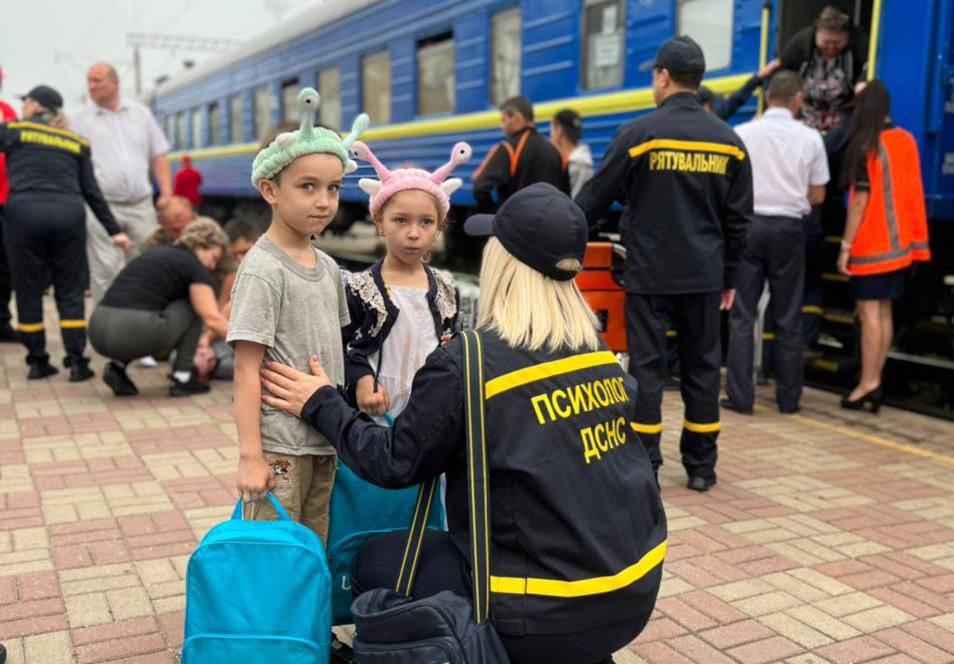It took Yulia, a mother from Kharkiv, Ukraine, seven days to reach the Polish border with her one-year-old daughter and nine-year-old son. They packed their bags in 10 minutes and rushed out of their home as shells exploded.
“I decided to leave the house and our whole life with only one goal,” she said. “To save the children and survive.”
Yulia and her family are among the more than 16 million Ukrainians who have left the country or been internally displaced since the war started on February 24, 2022. More than five million children from the country are in need of humanitarian assistance.
The scale and speed at which the humanitarian crisis in Ukraine unfolded has not been seen since World War II.
To meet the sudden and enormous needs of a population in flight, humanitarian organizations across the region leapt into action, including the United Nations Children’s Fund, the world’s largest organization defending children, which has been on the ground in Ukraine since 1997.
Life changed almost overnight. Heavy fighting and explosions damaged civilian infrastructure, including hospitals and schools. Homes have been destroyed and casualties reported, including 346 children as of mid-July. Mothers continued giving birth, and hospital staff risked their lives to protect fragile newborns. Across the country, damage to the water network and power outages left families without access to safe water.
The war in Ukraine is an all too familiar reminder of why UNICEF was founded over 75 years ago. Its purpose then was to help millions of new refugees across Europe. The organization now works in 190 countries on behalf of all the world’s children.
UNICEF responds to the same needs of children in conflict zones—protection, clean water, food, education, but many of its solutions are new. UNICEF USA’s Bridge Fund is an innovative financing mechanism that moves money into emergency situations more quickly. Because children shouldn’t have to wait.
Creative philanthropy
The Bridge Fund started 10 years ago to leverage capital markets to speed the procurement and delivery of supplies and programs. It was designed as a fix to an age-old problem: the days, weeks, and sometimes even months-long delay between the time donors agree to give money in an emergency, such as the conflict in Ukraine, to when it reaches organizations on the ground.
The solution is novel. The Bridge Fund controls a large pool of protected grant funding and borrows against that at a rate of $3.50 for every grant dollar. That means trucks full of supplies – clean water, first aid kits, midwifery kits, emergency surgical equipment and resuscitation kits – arrive earlier, which translates directly into lives saved.
The Bridge Fund support also contributed to UNICEF and UNHCR, together with local authorities and partners, quickly setting up a network of Blue Dot centers along refugee travel routes to provide respite, guidance, information, and child protection services — including family tracing and reunification — for children traveling alone or separated from their caregivers.
It has also enabled classes and activities to be set up subway stations where many children and their families took shelter from gunfire and shelling.
This is how a six-truck convoy arrived in the Ukrainian city of Lviv on March 5 carrying an estimated 70 tons of crucial medical supplies shipped from UNICEF’s Global Supply and Logistics Hub in Copenhagen, the largest humanitarian warehouse on the planet.
The fund has so far provided $19.1 million to expedite UNICEF’s humanitarian response in Ukraine.
Humanitarian finance
At a time when investors are increasingly evaluating the impact their investments have on the world, true innovative financial mechanisms like the Bridge Fund are leading with social good as the goal. We need to ask how organizations across the board can tap into trillions of dollars of private capital for good. And we need to make it attractive to investors.
Bridge Fund investors, for instance, get a return of capital and a return on capital.
Philanthropy alone cannot solve some of the biggest challenges facing children. We need multiple kinds of financing to respond to the intensifying war in Ukraine and the other emergencies across the globe.
UNICEF continues to call for an immediate ceasefire in Ukraine and to protect all children from harm. Until then, humanitarian aid continues to be imperative. As more institutions, investors, and NGOs seek a way to make a difference, we urge them to look into impact investing and innovative finance, underutilized tools that could saves children’s lives.
Cristina Shapiro is the president of UNICEF USA’s Impact Fund for Children, the impact investing affiliate of UNICEF USA.











